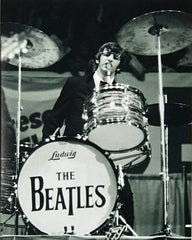As we've acquired collections of awards and memorabilia from record industry executives, artist teams and others, we inevitably end up with some that would have been wonderful pieces of music history but instead are damaged. This not only ruins them for their current owner, it also robs the ability for future collectors to enjoy them. After all, this is not the way a record award was meant to look: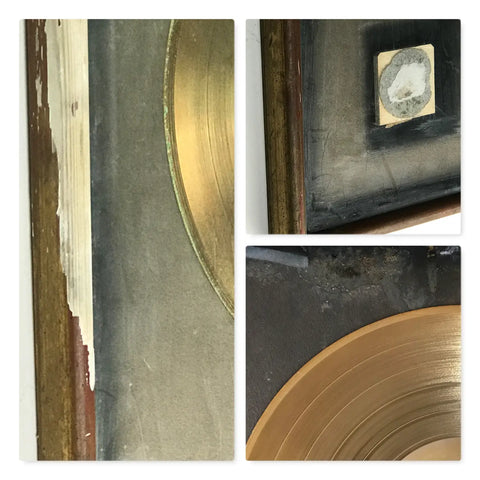
The sad thing is that much of the damage we see could have been avoided if some simple display and storage principles were considered over the years.
One solution is, of course, to lock awards and memorabilia up in darkened, perfectly climate controlled, humidity-free, pest-free storage facility. But even though investors in music memorabilia may want to do just that -- and probably should, in order to fully protect their investment -- the average person wants to display and enjoy the pieces they've collected.
So breaking this down into awards and memorabilia displayed vs. stored, here are some recommendations:
Display
When it comes to displaying your items, environmental factors are the most important in keeping your memorabilia in the best shape possible. Some of these tips are obvious, some not, but following them can keep your items looking as good as they can for the longest time possible.
Light: If you plan to have your awards or framed memorabilia such as a vintage tour jacket etc. hanging on a wall, give some thought to the location you choose. A spot with the least natural light possible is best. Generally, light--and especially UV light such as that from the rays of the sun and even some electrical lights--is the most damaging and you should avoid exposing your memorabilia to it.
Here's an example of the kind of significant effect light can have on an item's matte. This is what should be a uniformly dark charcoal-colored pebble texture matte. Found in a trashed 1975-81 RIAA "floater" award, look at the square area where the album cover miniature has fallen off that has been protected from light versus the rest of the matte that has been exposed to light over the years:
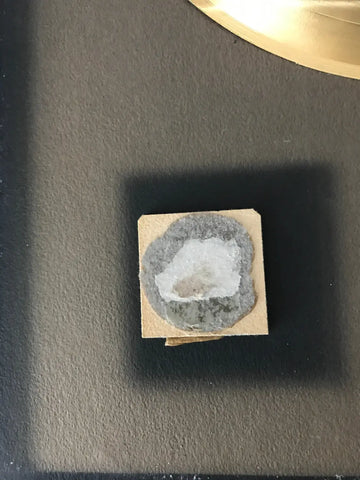
Temperature: Extreme heat or cold is not good for artwork, and certainly not for record awards. While older awards with metal mother discs stand up to heat better, newer awards made after the early 80s have coated plastic discs that do very poorly in hot temperatures.
In extreme examples, the underlying plastic disc becomes warped completely. This kind of damage can be caused if an award is left in a closed car in summer, for example. This is a reminder of the damage that can occur when items are transported or left in a vehicle, so be wary of this as well.
A more common problem in all of the newer awards with plastic discs is that, with even moderate heat, separation of the gold or silver ("platinum") metallic coating on the discs can occur. Here's an example of what that damage looks like, and there is no way to repair this, outside of replacing the entire disc:
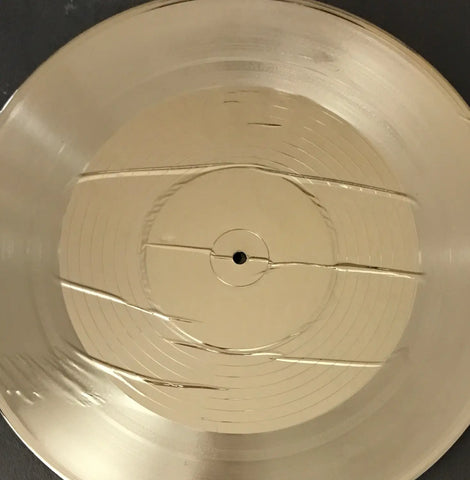
Humidity: Humidity is another destroyer of memorabilia. In highly-humid environments problems can range from mold growth and degradation of record disc finishes to warping of mattes and other paper-based materials.
Humidity can also cause the adhesives and tapes used in record awards and framed memorabilia to degrade over time, causing components to become dislodged and fall down inside the frame.
Storage
Needless to say, the same environmental considerations regarding light, temperature and humidity apply to items in storage. In terms of light, a completely dark closet or storage room is best since it will provide maximum protection. Ideally, your storage area should be climate-controlled to maintain a stable 68F/20C degree environment year-round.
Sheds, garages and similar locations are not great places to store awards or memorabilia items, most especially in areas with high humidity. An extreme example of course, but here's what an unfortunate RIAA floater award victim looked like after a stint in a shed somewhere in the humid northeast U.S.:
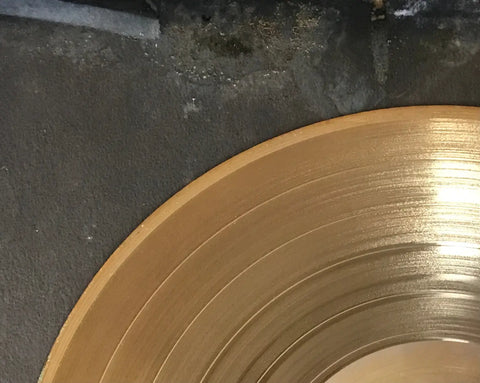
Here are some other considerations when storing memorabilia:
Storage Position: This mainly applies to record awards but can also be important for other framed items. The main point here is to store framed items flat on their backs, with the components facing up so that gravity is not constantly pulling at the components and weakening tapes and adhesives.
Remember, for example, that on 1964-74 RIAA "white matte" awards, the relatively heavy metal mother discs were only held in by criss-crosses of standard masking tape. Constant pulling in the wrong direction can cause the disc to pull loose.
Not only will this then require a repair to look good again but, on an award with an original backing paper, it can negatively affect the value of the award--at least to a purist collector who values originality.
Storage Bags/Cardboard Corners: Consider investing in some acid-free polyethylene bags to encase your framed items in and protect them from dust, dirt and tiny creatures. There are many brands and sizes available to meet your needs but be sure to choose 2 mil or thicker bags and that they are made from polyethylene. Bags that are not acid-free can eventually stain wood, card stock, and paper so stay away from them.
Cardboard corners can be used to help store awards or framed items in a stack by providing a spacer. This will prevent damage to backing papers from hanger wires and hooks:
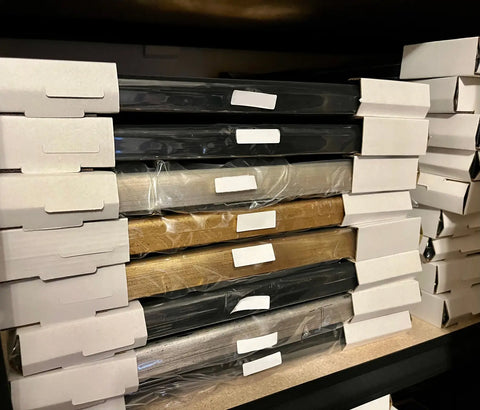
And, not to state the obvious, but if you have insect or other pest problems, you'll definitely want to choose a storage spot that is treated to prevent these as well. Pests often find the adhesives, fabric and other odd bits of your memorabilia to be attractive feasts so you definitely want to prevent that.
So, give some thought to how you display and store your record awards and memorabilia. It will ensure your treasures look great for as long as possible and also protect your investments.
Check out our current selection of RIAA and other collectible record awards here. Interested in other kinds of music memorabilia? Check that out here.
Want to learn more about RIAA and other record awards? Check out our Record Award Guide here.
Important Notice/Disclaimer: While many record awards and music memorabilia items appreciate in value, others fall in value and MusicGoldmine.com makes no claims, express or implied, that any item will appreciate in value at any time in the future. Further, MusicGoldmine.com is not providing investment advice in any of its' content.



